Olivier Messiaen is indeed an extraordinary musician. Although best known as a composer, he has achieved international acclaim as a theorist and teacher as well. Most of Messiaen's compositions are for solo piano or organ, but his published uvre also includes a number of works for a variety of instrumental and vocal combinations. In addition, three pedagogical works have been completed, with a fourth Traités de rythme, in preparation. Messiaen's illustrious pupils at the Paris Conservatoire have included Boulez, Stockhausen, and Xenakis. In his book Notes of an Apprenticeship, Boulez has expressed a feeling of indebtedness to Messiaen for his varied and unique contributions which have affected the evolution of musical style.1
Numerous eclectic and innovative techniques and devices are employed in Messiaen's works. As one might expect, the earlier compositions especially evidence the influence of impressionism, a style in which the composer was well schooled. However, Messiaen was hardly content to remain merely another "post-impressionist" for very long; he soon modified the harmonic, melodic, and rhythmic materials of his predecessors to suit his personal tastes. In addition he began to introduce strikingly novel and engaging ingredients which were to become trademarks of his later style. A few of these fascinating components, such as bird songs and Hindu melodies, have been employed almost exclusively by Messiaen. Several others, such as nonretrogradable rhythms, added values, modes of limited transpositions, interversion of notes, and serialization of attacks, dynamics, rhythm, and register have since been used in a similar or altered manner by a number of successful contemporary composers.
Messiaen has discussed his musical attitudes at length in his Technique of My Musical Language.2 While this treatise discusses and provides examples of several harmonic structures, it does not elaborate on the pervasiveness with which these harmonies occur throughout any particular voice. All examples are brief and are restricted to compositions written before 1944, when the Technique was first published.
The present investigation concentrates on harmonic structures in the solo piano works from the earliest pieces through the innovative post-World War II Quatre études de rythme. In view of the large number of works, a lengthy discussion of each work is not feasible. However, significant evolutionary trends as well as common denominators of style are noted. While the focus is on the disposition of chord tones in structures viewed as separate entities, attention is also given to other factors such as melody, register, chord spelling and progression, and form when relevant to understanding the composer's harmonic idiosyncrasies.
The earliest published pieces, completed in 1929 and published the following year, are collectively entitled Préludes. The first of these, "La colombe" (The Dove), shows several impressionistic influences (see Ex. 1).
Ex. 1. Messiaen, "La colombe," mm. 1-9, from Préludes (Durand et Cie, 1930.) manuscript p. 3, line 2
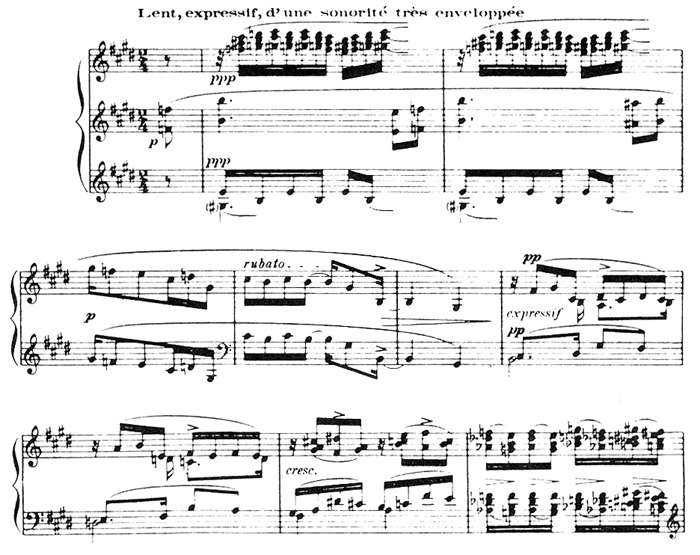
An immediate feature is the characteristic three-stave score; others are the tertian spellings and the use of traditional chords with added tones. Right away the stamp of Messiaen is seen. While the composer employs the traditional four-sharp signature for E Major (and the tonal center does appear to be E) he uses a scale which is neither major, minor, modal, pentatonic, nor whole tone. Instead a scale comprised of the following tones is employed: E, F, G, G-sharp, A-sharp, B, C-sharp, D, E. This series of notes is Messiaen's second mode in its second transposition and serves as the melodic and harmonic basis of measures 1 to 5.3
In keeping with the impressionistic tradition, it is not uncommon to find "added note chords." However, even in such an early example as this, the added note may be a poignant dissonance, as in the penultimate chord of measure 9 (G-sharp, B, C, D-sharp), rather than the conventional second or sixth added above a chord in root position.
Another piece from the same collection, "Chant d'extase dans un paysage triste" (Song of Ecstasy in an Unhappy Country), reveals the composer's thorough rooting in the earlier impressionistic style (see Ex. 2).
Ex. 2. Messiaen, "Chant d'extase dans un paysage triste," mm. 1-9, from Préludes (Durand et Cie, 1930.) manuscript p. 3, last paragraph, line 4
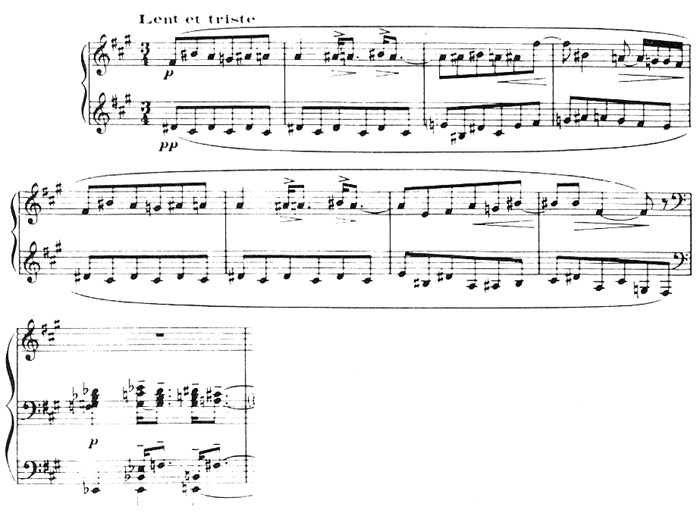
Again a traditional signature (three sharps) is used in accordance with the F-sharp tonality which is confirmed by the cadence in measure 8, where both voices sound an F-sharp. It may be noted that the F-sharp tonal center is not asserted at the beginning of the piece. The upper line tends to suggest the tonality of A, as this tone is frequently repeated and surrounded by neighboring tones. However, in the lower voice the tonality of A is not confirmed; D-sharp appears to function as a key note surrounded by other tones. Furthermore, the top voice begins and ends on F-sharp, even though this pitch does not appear to be the tonic at the beginning.
Such scalar ambiguity is of course not an innovation of Messiaen. Examples which demonstrate a similar effect abound in the work of Debussy. One well known case is the beginning of the "Sarabande" from Debussy's Suite pour le piano, where the tonal center might be heard as E Major or G-sharp Phrygian.
Several other traditional features may also be observed in this prelude, among them the impressionistic harmonies which pervade the piece. The composer's awareness of traditional structures is clearly indicated in measure 9 (see Ex. 2). In the second quarter-note beat the harmony is spelled E-flat, G, B-flat, D-flat, F, but the tone E-flat is written as D-sharp in the next sonority (E, G, B, D-sharp). As this structure is a minor-major seventh chord, it may seem needless to comment on the selection of the tone D-sharp rather than E-flat. However, such consistency of traditional sounds and spellings is a feature not often found in later works.
As in impressionistic music, spacing of structures frequently provides insight to the composer's harmonic concept. For example, chords in measure 12 (see Ex. 3) would be subject to numerous interpretations without the clarification offered through arrangement of tones on the three staves. In this context Messiaen's multiple superposition of tertian structures is apparent.
Ex. 3. Messiaen, "Chant d'extase dans un paysage triste," m. 12, from Préludes (Durand et Cie, 1930.) manuscript p. 4, last line
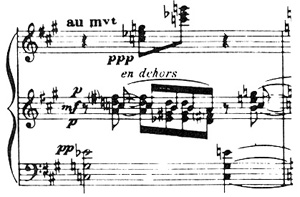
A second early work, Fantaisie burlesque (1932), evidences many of the conventional techniques seen in the two preludes just examined, but also includes a greater number of harmonies not found in impressionistic pieces. As in the earlier compositions, a key signature (one flat) is employed to represent appropriately a tonality of F (see Ex. 4).
Ex. 4. Messiaen, Fantaisie Burlesque, mm. 1-10 (Durand et Cie, 1932.) manuscript p. 5, paragraph 2, line 5
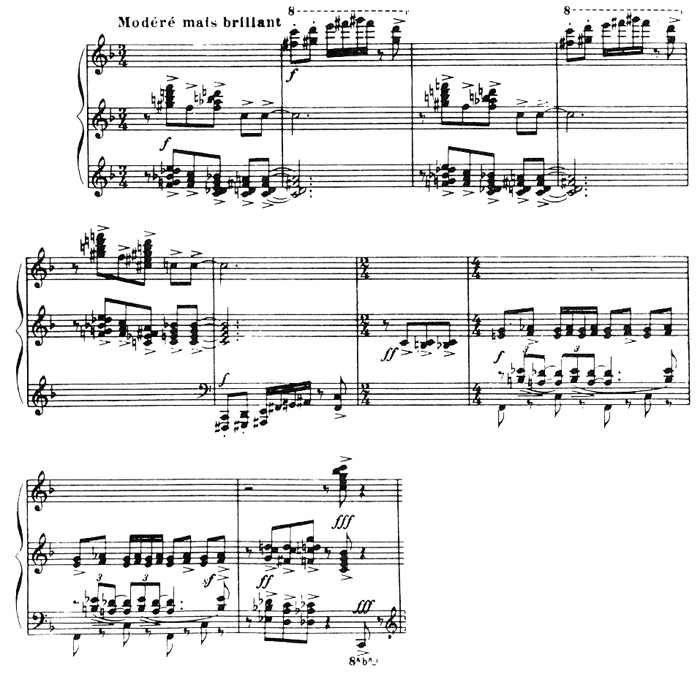
As evidence of Messiaen's familiarity with earlier styles, tonic and dominant tones (F and C) are sounded in the lowest voice of each chord in the opening measure. In measures 8 and 9 tonic-dominant tones are employed as pedal tones. Measure 10 illustrates usage of dominant sevenths functioning non-traditionally, in a planing fashion in this case, as employed by the impressionists. However, addition to these chords of notes which are neither seconds nor sixths above the bass is not characteristic of Messiaen's forerunners. Tertian spellings of these structures is of course in keeping with the traditional sonorities.
Another example of an earlier influence may be noted in this work in measure 29 (see Ex. 5), where a dominant seventh with added sixth is found.
Ex. 5. Messiaen, Fantaisie Burlesque, m. 29 (Durand et Cie, 1932.) manuscript p. 5, last paragraph, line 2
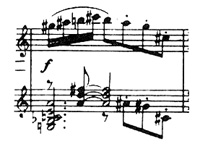
In this example the melodic tones in the right hand (G-sharp, A, B, C-sharp) do not stem from the harmony, and another chord (D, F-sharp, A) is also heard in the middle register. With the melodic tones B and C-sharp from the top stave added to the triad in the middle register, yet another chord with added sixth would be produced: D, F-sharp, A, B, C-sharp. Although the composite chord, a rather dense sonority, appears to sound more like Messiaen than his predecessors, the constituents of the total structure are nevertheless born of familiar origins.
In examining a brief passage within this work (see Ex. 6), it may be observed that Messiaen occasionally tends to begin a phrase (measure 97) with at least a partially tertian-based structure and move to less definitive harmonies within the course of the phrase.
Ex. 6. Messiaen, Fantaisie Burlesque, mm. 96-99 (Durand et Cie, 1932.) manuscript p. 6, paragraph 2, line 1
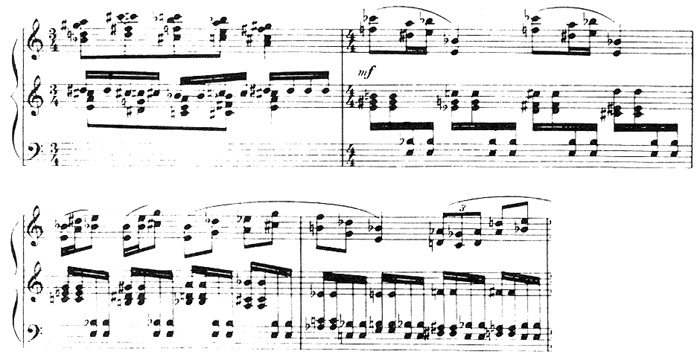
In this example the first chord in the middle stave of measures 97, 98 and 99 respectively is a root position triad which expands chromatically in contrary motion. While the first two chords in each measure are clearly triads, the third chord in each group seems to be an incomplete seventh chord, and the fourth structure is an even more incomplete ninth chord.4 In the top stave all intervals are tritones, which give a tonal uncertainty to the writing. Rather unusual are the recurring tritones in the lowest stave, but the persisting E-B-flat interval (which occurs three times in the top stave also) serves to bind the passage together, even if on a dissonant basis.
One additional observation should be made concerning choice of register. Although a number of harmonic constituents are common to many contemporary composers, the position of these tones and the manner in which they are connected may differ drastically. Messiaen is particularly fond of writing in the highest and lowest registers in succession. Measures 1 to 5 and measure 6 (Ex. 4) illustrate successive employment of sharply contrasting registers, a feature seen throughout this work and frequently in many other compositions for piano.
After a period of nine years another piece for solo piano appears entitled Rondeau (1943). While several novel characteristics are seen in this work, most techniques found herein are firmly rooted in the past. However, unlike the two earlier pieces mentioned previously, Rondeau does not employ a key signature, although the opening tonality clearly appears to be E (see Ex. 7).
Ex. 7. Messiaen, Rondeau, mm. 1-4 (Alphonse Leduc et Cie, 1943.) manuscript p. 7, paragraph 2, line 6

The repeated B's in the first measure sound as dominants to the tonic E which is asserted through reiteration in measures 2 and 3. In measure 12 (see Ex. 8) there is seen a grace note structure which is especially characteristic of Messiaen's later works in its arrangement of chord tones in pairs (A, E versus D-sharp, G-sharp), use of a very high register; and absence of a tertian basis.
Ex. 8. Messiaen, Rondeau, mm. 9-12 (Alphonse Leduc et Cie, 1943.) manuscript p. 7, paragraph 2, line 8

All of these features may be found in combination several times throughout this piece and much more often in later works. The composer's distinctive use of extreme registers in succession may also be observed in this measure.
One of the first indications of Messiaen's interest in bird songs appears in measure 30 (see Ex. 9).
Ex. 9. Messiaen, Rondeau, mm. 29-30 (Alphonse Leduc et Cie, 1943.) manuscript p. 7, last paragraph, line 2
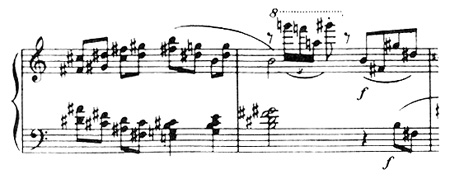
Although the composer does not label the melodic passage G, F, A, G-sharp as a bird song (as he usually does in later pieces), the angularity of the line which is sounded in rapid tempo is consistent with this style. It may also be noted that three of the four melodic tones do not stem from the added sixth harmony built on a B major triad. Such melodic-harmonic polarity is particularly characteristic of the more mature compositions. Except for the few features mentioned above, however, the majority of devices in this work give evidence of Messiaen's close ties with impressionism. Tonality is clear nearly throughout, and characteristics such as pentatonic harmony, triadic planing, and added sixth chords are also common.
Although the next composition, Vingt regards sur l'enfant Jésus, was written only one year after Rondeau, in 1944, it manifests many strikingly new techniques not seen in the works already discussed. Like the Préludes, Vingt regards is a collection of pieces, but the Regards are much lengthier compositions. Three themes recur throughout a number of the 20 pieces: Thème de Dieu (Theme of the Lord), Thème de l'étoile et de la Croix (Theme of the Star and the Cross), and Thème d'accords (Theme of Accord). Other themes of less cyclic significance also occur in several pieces.
Each of the 20 Regards is characterized by conspicuous consistency of texture throughout or by dramatic contrasts of texture. The first, "Regard du Père" (The Look of the Father), is of the former type; thick sonorities with many doublings are employed in every measure. While many of these pieces are hardly tonal, "Regard du Père" does employ the key of F-sharp Major quite consistently, as the pervasive Thème de Dieu provides a tonal basis in the lower two staves. Of the five chords in the Thème (see Ex. 10) all except the second structure are major triads. The Thème de Dieu returns throughout the piece, either in original, transposed, or incomplete versions.
Ex. 10. Messiaen, "Regard du Père," m. 1, from Vingt Regards sur l'Enfant Jésus (Durand et Cie, 1947.) manuscript p. 8, last paragraph, line 8
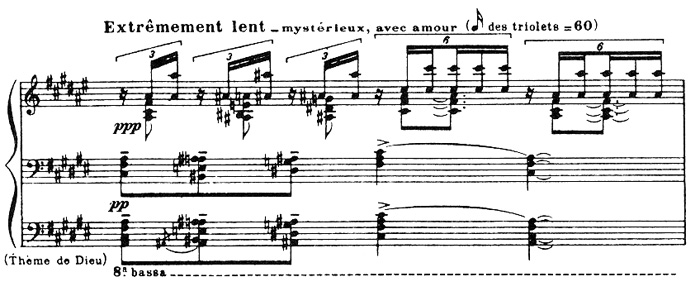
In contrast to "Regard du Père," "Regard de l'étoile" employs a quantity of nontertian structures. Traditional chords and spellings are used, but only in brief passages. While the first "Regard" was characterized by consistency of texture, "Regard de l'étoile" offers frequent and striking textural contrasts. Recurrence of various motives at their original pitch levels serves to unify the work. For example, measures 1 to 5 (see Ex. 11) recur intact twice during the course of the piece.
Ex. 11. Messiaen, "Regard de l'étoile," mm. 1-5, from Vingt Regards sur l'Enfant Jésus (Durand et Cie, 1947.) manuscript p. 9, paragraph 3, line 4
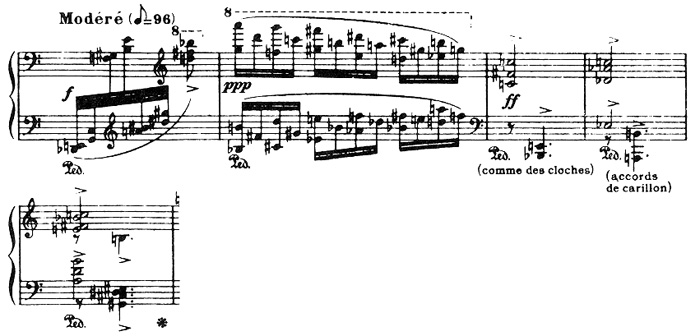
In each of these five-measure segments, three conspicuously different textures may be seen: that of measure 1, measure 2, and measures 3 to 5. After its initial unaccompanied appearance during the earlier part of the piece, the Thème de l'étoile et de la Croix is also sounded at a later point as a cantus firmus with harmonies added above. Although many harmonies and devices in the "Regard" are quite unlike those used by the impressionists, a few ties with the past are apparent. Occasional quartal structures may be found and familiar techniques such as harmonic planing (although not strict and not of major or minor triads or dominant sevenths) and triadic arpeggiation (which is brief and soon interrupted by one or more nontertian structures) are not common.
In looking at "L'échange," the third of the Vingt regards (see Ex. 12), one perceives that a small number of motives pervade the piece.
Ex. 12. Messiaen, "L'échange," mm. 1-6, from Vingt Regards sur l'Enfant Jésus (Durand et Cie, 1947.) manuscript p. 9, last paragraph, line 1
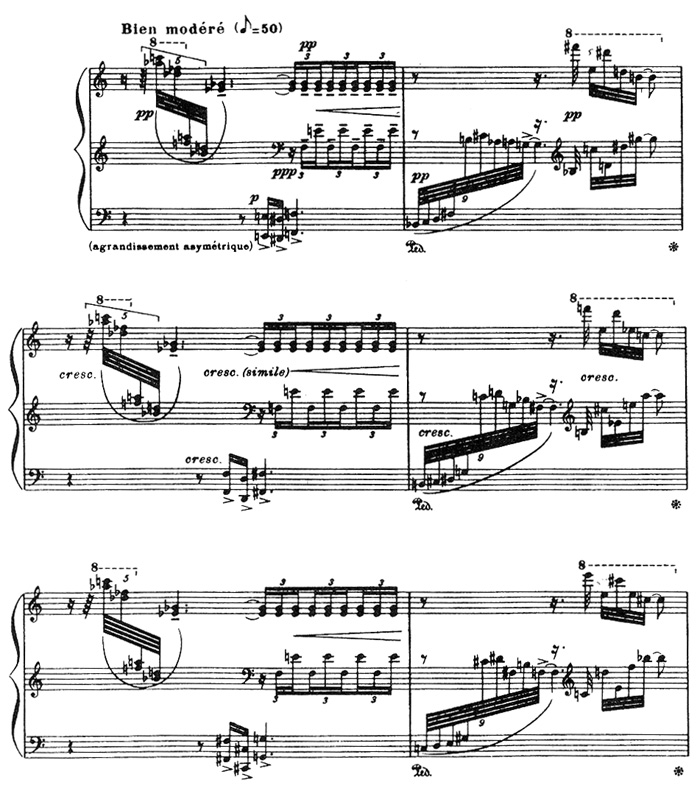
This compositional practice is consistent with the first two "Regards" just examined. In comparing this piece with the two previous ones in this collection, it may also be noted that consecutive pieces employ conspicuous contrasts of texture. This composition represents nearly a complete break with earlier practices in its use of harmonic materials. Traditional influences are virtually nonexistent in this work. Harmony is essentially a byproduct of linear materials which are treated in systematic fashion throughout. Such a procedure is reminiscent of, though not the same as, Bartók's "accidental dissonance" technique, whereby melodic lines are combined at varying pitch levels with only secondary concern given to the harmonic results. Of course a glaring difference between the style of Messiaen and that of Bartók is in the linear materials themselves, not to mention the respective treatments thereof.
Only brief mention will be made here of the fifth "Regard," "Regard du Fils sur le Fils" (The Look of the Son at Himself), but it cannot be ignored since several unique devices are employed simultaneously in the opening of this work. At the very beginning, polymodality, rhythmic canon, and the Thème de Dieu are found (see Ex. 13).
Ex. 13. "Regard du Fils sur le Fils," mm. 1-7, from Vingt Regards sur l'Enfant Jésus (Durand et Cie, 1947.) manuscript p. 10, last paragraph, line 5
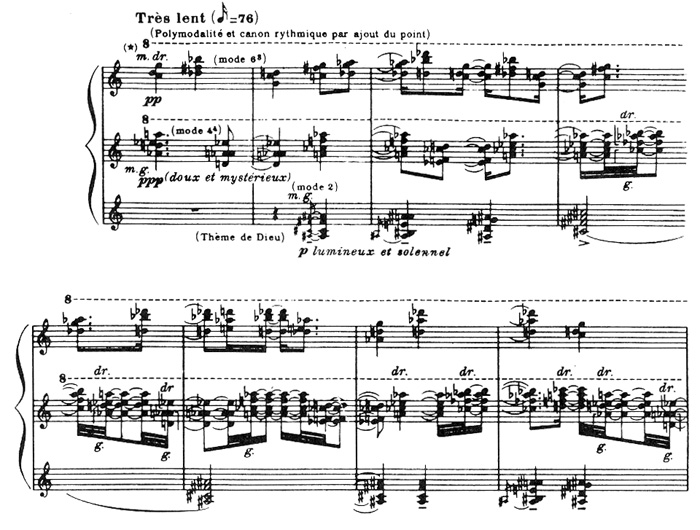
Messiaen uses the sixth mode in its third transposition in the top stave, the fourth mode in its fourth transposition in the middle stave, and the tonal Thème de Dieu, based on mode two, first transposition" in the lowest stave. Rhythmic canon is seen in the two top staves. Values in the middle stave are one-and-a-half times those of the top stave. Such a combination of techniques reflects Messiaen's penchant for juxtaposition and superposition of contrasting entities.
Perhaps the best known of Messiaen's works are his Quatre études de rythme of 1949-50. These brief but complex works manifest a variety of techniques not seen in earlier compositions, and employ almost none of the traditional harmonies associated to varying degrees with earlier pieces. Undoubtedly the most famous of the Etudes is the Mode de valeurs et d'intensités, as this work illustrates serialization not only of pitches but of attacks, dynamics, register, and rhythm as well. Twelve different notes of differing rhythmic values are found in each of the three octaves. However, the "row" is not treated in the manner of Schoenberg, in which 12 notes usually sound before a tone is repeated. Instead, Messiaen tends to use segments of the row. Although the composer provides no pedaling indications, it would appear impossible to perform the piece without the pedal, as examination of any page of the score will verify (see Ex. 14).
Ex. 14. Messiaen, Mode de valeurs et d'intensités, mm. 1-3 (Durand et Cie, 1949.) manuscript p. 11, paragraph 2, line 3
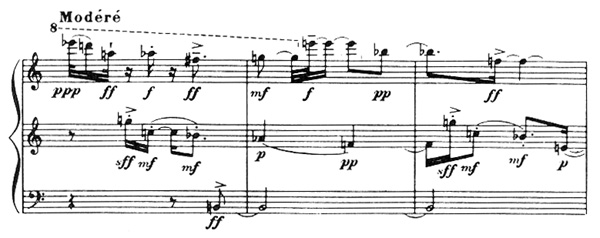
Consequently, assessment of harmony would vary somewhat according to application of the pedal. Nevertheless, it is apparent that Mode de valeurs et d'intensités employs a harmonic language completely different from that of earlier works.
Written in the same year as Mode, Neumes rythmiques also attests to Messiaen's post-World War II style. Almost none of the structures in this work are tertian sonorities (see Ex. 15).
Ex. 15. Messiaen, Neumes rythmiques, mm. 1-7 (Durand et Cie, 1949.) manuscript p. 11, paragraph 3, 1ine 3
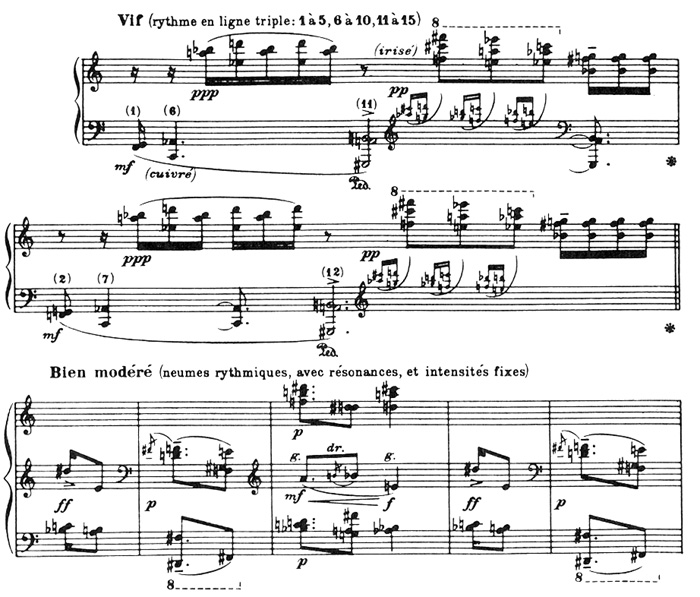
Only a very few chords might be heard as traditional sounds or derivations therefrom. As in previous works, a few motives recur frequently in the same or nearly the same arrangement. For example, measures 1 and 2 (Ex. 15) are seen as identical structures in several subsequent measures; only rhythm is altered. Cluster harmonies, particularly characteristic of Messiaen's later works, are also seen here. The familiar and dramatic contrasts of register and texture may be observed in every passage.
In the two remaining Etudes are found several characteristics not seen in any of the pieces previously discussed. Both Ile de feu I and Ile de feu II employ Hindu melodies in extended two-voice passages. The melody in the top stave of measures 93 to 98 of Ile de feu II (see Ex. 16) illustrates this style, characterized by many repeated notes and occasional large skips.
Ex. 16. Messiaen, Ile de feu II, mm. 93-98 (Durand et Cie, 1950.) manuscript p. 12, paragraph 2, line 4
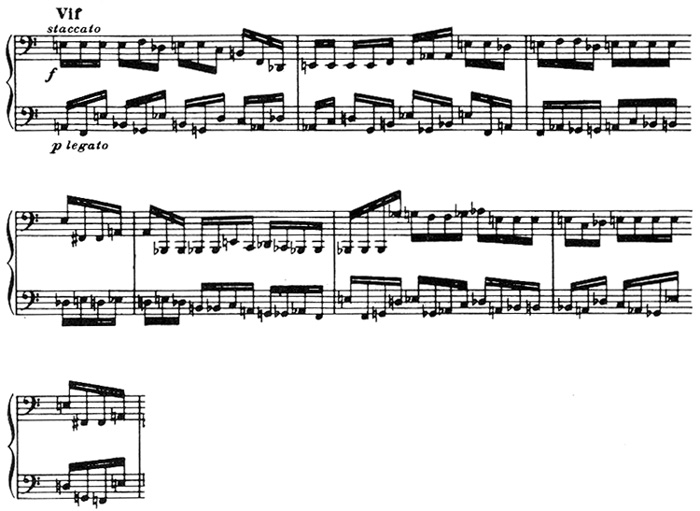
In this example (and several subsequent measures) the Hindu melody is accompanied by a series of 12-tone statements and their retrogrades. (In each case the twelfth tone of the original is not repeated in the retrograde.)
In Ile de feu II are found 10 interversions, employed here as 12-tone rows which are presented in ordered sequences. (See Ex. 17 for illustration of these permutations.)
Ex. 17. Ten interversions from Ile de feu II. manuscript p. 12, paragraph 3, line 2
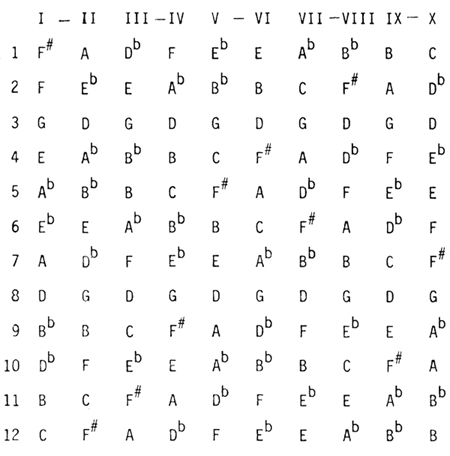
The first note of each row is always the last of the next, the second is the tenth, the third the eighth, the fourth the sixth, and so forth. The 10 interversions are sounded in five pairs (I and II, III and IV, etc.). Given the sequential arrangement of tone within each row, one note in an interversion may only be paired with one of two their notes in another interversion. While the musical application of these restricted possibilities is somewhat freer, i.e., in some cases a note may sound with several others, or it may not sound with its paired note at all, it is apparent that harmony is to a significant extent an outgrowth of predetermined mathematical ordering.
Although very few structures in these works are tertian, a number of techniques found herein are similar to those of previously discussed pieces. For example, bird song, planing of untraditional harmonies, superposition of quartal and quintal harmonies, and superposition of a nontertian chord above a tertian sonority are found in Ile de feu I. In Ile de feu II, planing of quartal and quintal structures and extended reiteration of a particular harmony may be observed. In both Etudes, examples of textural contrasts and extreme registers abound.
In conclusion it may be stated that Messiaen's harmonic language evolved subtly but significantly during the 20 year period between the appearance of the Préludes in 1930 and the completion of the Quatre études de rythme in 1950. Gradually impressionistic ties were shed as the composer firmly established his own vocabulary in the post-World War II pieces. As a personal harmonic style was established, unique melodic and rhythmic devices were employed with greater frequency. Consequently it became increasingly difficult to examine harmony in Messiaen's music without reference to these engaging techniques which exerted influence on his harmonic style. In spite of conspicuous chronological modifications, most of the composer's works have a few common traits. These are (1) use of extreme ranges in close proximity, (2) dramatic contrasts of texture, (3) economy of material, (4) readily perceivable forms, (5) bird song, and (6) tertian and nontertian structures (to varying degrees and in differing manners). Materials such as modes of limited transpositions and added note chords are found almost exclusively in the earlier pieces, while techniques such as interversion, Hindu melodies, nonretrogradable rhythms, and serialization of pitches are virtually exclusive properties of the later compositions.
1Pierre Boulez, Notes of an Apprenticeship, ed. Paul Thevenin, translated by Herbert Weinstock (New York: Alfred A. Knopf, 1968), pp. 173-174.
2Olivier Messiaen, The Technique of My Musical Language, 2 vols., translated by John Satterfield (Paris: Alphonse Leduc, 1956).
3See Messiaen, The Technique of My Musical Language, I, 59 and II, 50.
4In measure 99 the highest tone of both the seventh chord and ninth chord must be enharmonically respelled.


